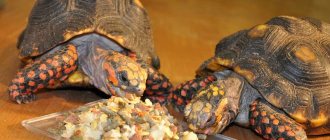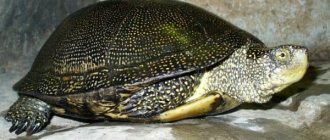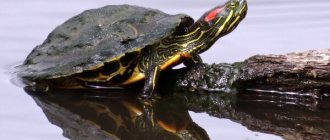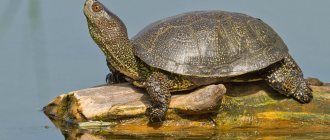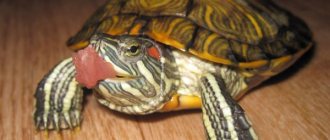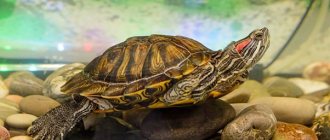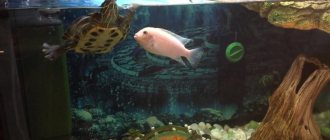Even in the most ancient times, humanity tried to tame wild animals, keeping them with them as their most faithful and devoted friends. Everything flows, everything changes, but not this habit. The only difference is that previously it was customary to have cats, dogs and parrots, but now they have more exotic pets - chinchillas, newts and even a marsh turtle.
Swamp turtles love ponds with stagnant water
European marsh turtle and its maintenance at home
For an animal such as the European marsh turtle, maintenance can be organized at home if you know certain rules.
But to do this, you need to know what a marsh turtle is and what care it needs at home. Therefore, before getting such a pet, you need to familiarize yourself with the characteristics of its life and needs. Also, it must be taken into account that being kept at home cannot be compared with a free life, no matter how ideal it may be. This means that the marsh turtle at home usually does not live as long (despite the absence of the threat of death from predators) and is smaller in size. But it is possible to organize optimal conditions for it. The basic needs of this reptile at home:
Although it is possible to provide a quality home for an animal such as the European Swamp Turtle, you need to think carefully before making a decision. Deprivation of its natural habitat is difficult, especially if the animal first lived in the wild. Therefore, it is not worth catching these animals.
For a pet like a marsh turtle, care requires taking into account the peculiarities of its behavior.
They have the ability to quickly adapt, so they can easily transfer to an aquaterrarium
It is very important that the animal’s new “home” has a dark place to rest.
They are distinguished by high mental abilities. The reptile quickly understands that the owner is feeding them, so it reacts to his appearance. However, you should be careful when feeding. Turtles tend to be cunning; they bite and scratch. That's why you shouldn't let children touch them. It is also not advisable for adults to frequently handle such pets. Sometimes there are individuals who are not at all characterized by aggression and who do not avoid people or hide from them under their shells. But most often the behavior of these animals is unpredictable.
What to feed a marsh turtle at home
Living in the wild, the marsh turtle chooses its own food, but when it is at home, care and feeding fall on the owner. Therefore, he needs to know what the swamp turtle eats.
The European marsh turtle, which is kept at home, must eat properly. Otherwise the animal will die. Her diet must be balanced so that the pet receives all the necessary nutrients. Feeding the reptile must be done in water.
The main types of food for her at home:
As these animals grow older, plant foods become necessary, for example:
Young marsh turtles do not particularly need food of plant origin. They grow actively, so they need animal food.
The frequency of feeding depends on the age of the pet. Young turtles need food more often, so they should be fed daily. Adults can go several days without food, so they are fed 2 or 3 times a week.
Reproduction in captivity
The European marsh turtle, which is kept at home, has every chance of breeding
In this case, it is very important that the marsh turtle receives proper maintenance and care. It is necessary that during pregnancy the temperature regime be observed (about 2 degrees higher than usual)
It is also important to have a sufficient amount of calcium-rich food. Adequate UV light must be provided to allow nutrients, especially vitamin D, to be absorbed. During this period, females should be kept separate from males.
Conditions for masonry should be prepared. It is recommended to use a container placed in the aquaterrarium with a mixture of sand and vermiculite. If the size of the terrarium does not allow this, you can place the female in a separate box with soil, the depth of which should be at least 12 cm. After the female lays eggs, the clutch should be transferred to an incubator. For incubation, you need to maintain a temperature of 28-30 degrees and air humidity of 80%. The period before the birth of babies depends on compliance with these conditions and can last 2-3 months.
Selecting the site language
Afrikaans Albanian Amharic Arabic Armenian Azerbaijani Basque Belarusian Bengali Bosnian Bulgarian Catalan Cebuano Chichewa Chinese (Simplified) Chinese (Traditional) Corsican Croatian Czech Danish Dutch English Esperanto Estonian Filipino Finnish French Frisian Galician Georgian German Greek Gujarati Haitian Creole Hausa Hawaiian Hebrew Hindi Hmong Hungarian Icelandic Igbo Indonesian Irish Italian Japanese Javanese Kannada Kazakh Khmer Korean Kurdish (Kurmanji) Kyrgyz Lao Latin Latvian Lithuanian Luxembourgish Macedonian Malagasy Malay Malayalam Maltese Maori Marathi Mongolian Myanmar (Burmese) Nepali Norwegian Pashto Persian Polish Portuguese Punjabi Romanian Russian Samoan Scottish Gaelic Serbian Sesotho Shona Sindhi Sinhala Slovak Slovenian Somali Spanish Sudanese Swahili Swedish Tajik Tamil Thai Turkish Ukrainian Urdu Uzbek Vietnamese Welsh Xhosa Yiddish
What to feed
What to feed a marsh turtle at home is a fairly simple question. In their natural habitat, representatives of this species feed on almost everything they can find. Turtles do not disdain carrion. In addition to food of animal origin, the amphibian’s diet also contains algae and other food products of plant origin.
At home, you can feed marsh turtles:
- small fish and frogs,
- arthropods,
- shrimp.
Your pet will respond very well to the food offered to him.
- chicken and beef,
- small cockroaches and crickets,
- snails and newborn mice.
When feeding your pet, be very careful; at the sight of food, the turtle's predatory instinct awakens, making it a rather aggressive animal. Without meaning to, your pet can easily hurt your hand or even bite off your finger.
To maintain the predator instinct in your pet, it is necessary to at least occasionally introduce live food into your pet’s aquarium - no larger fish. The fish will be eaten along with all the entrails and bones.
An adult needs to be fed 2-3 times a week. Young turtles are fed every day. Do not overfeed your pet; most likely the turtle will eat everything you give it. You shouldn't do this. Determine how much food will be enough for your pet, and do not exceed this threshold.
Calcium and specialized vitamins for reptiles should be added to the diet of a pet turtle. They can be found in almost any pet store. These stores also sell food specially designed for reptiles; they can also be used to feed your pet, but you should not switch exclusively to this food. So, we figured out what marsh turtles eat, and how to set up an aquarium for your pet?
Ready food
Feeding a red-eared turtle exclusively with dry food is highly discouraged, but ready-made food can be included as an addition to the main diet, which should make up no more than 5-10% of the total diet. There are several manufacturers with more or less balanced nutrition for turtles. These include:
- Tetra,
- Nutra Fin,
- JBL,
- Sera.
A wide range of such food is produced in the form of flakes, tablets, granules and even capsules.
DIY turtle food
You can prepare food for your red-eared turtle at home.
For these purposes the following ingredients are needed:
- 70 grams of carrots,
- 50 grams of apples,
- 50 grams of white cabbage,
- 100 grams of squid meat,
- 150 grams of fish.
All this is passed through a meat grinder. Two eggs, prepared gelatin (dilute 30 grams in 150 ml of hot water until completely dissolved), 150 ml of milk are added to the mixture.
After stirring, let it cool and add twenty drops of the vitamin balance-correcting drug Tetravit.
This food can be stored in the refrigerator for one week. Before use, it must be cut into pieces. This volume of food is enough for 10 feedings for a turtle with a shell fifteen centimeters long.
Reproduction
After hibernation, the marsh turtle becomes sexually active, so the breeding season usually occurs in the spring. Sexually mature individuals mate near water bodies, after which, in the second half of spring - early summer, the female turtle lays eggs. The marsh turtle, whose eggs are eaten in some countries, lays several clutches of 10 to 20 eggs each per season. The eggs are laid in a dug hole, not far from the water, so that the small turtles can reach the reservoir within an hour. After a couple of months, small turtles are born.
Those who breed swamp turtles at home note an interesting fact. During the incubation period, the sex of the future turtle is affected by the ambient temperature. So, at temperatures below 25 degrees, male turtles are likely to hatch from eggs. If the air temperature exceeds 30 degrees, then most likely females will be born.
Protection measures
This species is listed in the Red Book of the International Union for Conservation of Nature (RL/nt), in provision II of the Berne Convention, and in the Red Book of the Republic of Bashkortostan. The population of this turtle species is in danger of extinction. Recent studies show that it is being replaced by a related species such as the American marsh turtle.
The main reasons for the decline in the number of the species are fishermen, land reclamation, and urbanization. A person finds marsh turtles near bodies of water or far from them. Most often, these are females who are looking for a good place to lay eggs at the mouths of rivers, and moving away from their usual habitat for a number of kilometers. People don't realize the damage they cause to nature when they take a turtle into their home. Even the best conditions in captivity can never replace natural ones. And very often turtles are kept in basins or, by and large, behind a closet, under a radiator, etc. When treated this way, the animal slowly dies over many years. Irreversible pathological processes occur in the turtle's body. For example: dehydration (the turtle dries out, the skull bones stand out on the head, the epidermis begins to adhere to the bones), loss of swimming membranes, overgrowth of the choanae, which can cause respiratory pathology, respiratory diseases, lack of heat leads to serious gastrointestinal diseases, various kidney pathologies, drying out and loss of the tip of the tail.
Lifestyle and behavioral characteristics of marsh turtles
Forest, steppe and forest-steppe areas with natural fresh water bodies are more suitable for these inhabitants. They love to settle in lakes, ponds, swamps, slow-flowing rivers and large water canals.
The most convenient for reptiles are reservoirs of natural origin located on flat terrain - with gently sloping banks and shallow areas, abundantly overgrown with plants and well heated. But you can also find the European marsh turtle in the mountains, where there are small bodies of water.
With the help of experiments, it was possible to prove that representatives of this species are capable of surviving for 2 days at a water temperature of 18°C and the absence of air. This confirms their high viability. During the mating season, adult turtles, ready to breed, can crawl out of the water and set off on a 300-500-meter journey inland.
Swamp turtles are excellent swimmers and divers, and they are also capable of staying under water for a long time, rising to the surface every 10-15 minutes. These animals are semi-aquatic reptiles and are most active during the daytime. They love to crawl onto land or islands and bask in the sun's rays.
Reptiles spend all the time that is not spent resting in search of food - they can eat all day long. And at night they go to sleep at the bottom of the reservoir.
Sense organs
This animal is distinguished by a high level of development of sensory organs. The main features are as follows:
- Vision. Red-eared turtles distinguish colors, choose the most suitable places to lay eggs, and look for other turtles. They also see moving objects, the distance to which can reach 40 m, well distinguishing predators and prey from each other.
- Smell. These reptiles search for food thanks to their developed sense of smell.
- Hearing. These animals hear poorly. This is due to the fact that their ears are hidden under the skin. Therefore, red-eared turtles react only to vibration.
- Touch. The turtle's shell is equipped with nerve endings, so it feels touch. The presence of taste buds allows these creatures to choose tastier foods.
- Voice. The vocal apparatus of turtles is not developed; they are only capable of snorting and hissing. Sometimes they make a squeak.
Dermatomycoses
Most often they arise due to gross violations of the conditions of detention, as a result of which the immunity and general resistance of the body are reduced. They are characterized by lesions of the skin or shell, in which a dirty gray coating appears on their surface, which later leads to the death of the tissue underneath. In this case, detachment of individual plates of the shell and its deformation may also occur.
Treatment must be started as early as possible; only in this case can success be achieved. For therapy, a solution of malachite green is used at a concentration of 0.15 mg per 1 liter of water. A turtle is bathed in it for 3 days for 15-20 minutes. After which the damaged areas are treated with Canesten cream.
If the lesion is severe, the intervention of a veterinarian will be required, who will remove the affected areas surgically. Also, in some cases, when bathing a turtle, it may experience eye irritation. The best prevention of dermatomycosis is good living conditions and a balanced diet.
Walking and swimming
From time to time the marsh turtle is allowed to walk around the room
However, it is important to keep an eye on the animal, as it is very active and can get stuck in hard-to-reach places. A turtle can live without water for more than a day, but it is advisable to release it onto land for a maximum of 3-4 hours
Then no harmful consequences for health (skin discoloration, injury, metabolic disorders) will occur.
Another rule for keeping a marsh turtle is regular bathing of the reptile. Novice breeders mistakenly believe that since the animal is in the water, there is no need to bathe it. In fact, aquarium water becomes polluted very quickly: even if you feed the reptile in another container, the environment is filled with waste products.
Therefore, periodically, about 1-2 times a month, the turtle can be bathed in a basin or sink with warm, settled water. The liquid level should not cover the pet’s head: approximately 2/3 of the shell. Bathing is carried out using an ordinary soft cloth, which is used to thoroughly wipe off dirt over the entire surface of the body, especially the shell. It is unacceptable to use detergents and hard brushes - otherwise they can damage the health of the turtle, penetrate into the eyes, and the bristles will scratch the shell.
Hibernation
One of the controversial issues in keeping and caring for a marsh turtle is whether to allow the animal to hibernate or not. In nature, individuals regularly lie to the bottom when the temperature in the reservoir drops to +10°C and below. However, in the south, in North Africa, such temperatures almost never occur. And marsh turtles are active throughout the season, i.e. They don’t fall asleep at all.
Since the home conditions are close to natural, and the temperature in the aquarium is always maintained at a consistently high temperature, the turtle will not want to hibernate, which is normal. But even if she fell asleep for several days, you should not force the reptile out of this state. It is enough to simply illuminate the aquarium and heat the water 2-3 degrees above normal temperature. Then the pet will “come to life” on its own, without additional influences.
Caring for a bog turtle is quite simple. The basic rule is to provide clean, warm water and a balanced diet. If you regularly monitor the aquarium, change the liquid, and illuminate it, your pet will live for several decades. In nature, she can live up to 45-55 years, and at home - up to 30 years.
Availability
The bog turtle can be found commercially or caught in the wild during the warmer months. But, with normal maintenance, owners with zero experience in breeding turtles successfully produce offspring.
All individuals kept in captivity are unpretentious and easy to care for.
However, it is important to note that to keep a marsh turtle, you need to create fairly precise conditions. And just bringing it and putting it in a basin won’t work. If you catch a turtle in the wild and you only need it for fun, then leave it where you found it. Believe me, this way you will make your life easier and will not kill the animal.
General principles of keeping at home
Naturally, a large reptile needs a lot of space. This is why (and for a number of other reasons) keeping representatives of Emys orbicularis is considered relatively difficult, which does not, however, affect the growing popularity of marsh turtles.
To live in captivity, these animals should be provided with an aquaterrarium. This means that the aquarium should have 2 zones - water and land. The capacity of such a “dwelling” should not be less than 100 liters; otherwise the turtle will feel cramped.
The “wet” zone occupies most of the aquaterrarium, and an island of land should be placed in one side of the terrarium. This island can be made from stones, fastening them together with aquarium glue. For safe and easy access of your pet to land, it is recommended to make a flat plastic bridge.
In an aquaterrarium with sandy or pebble soil, it is recommended to plant aquatic plants, the foliage of which will sometimes act as a good nutritional herbal supplement.
Heating
Natural sunlight is best, and it is advisable to expose baby turtles to direct sunlight during the summer months. However, this is not always possible and an analogue of sunlight must be created artificially.
To do this, in an aquaterrarium, above land, an incandescent lamp and a special lamp with UV rays, an ultraviolet lamp for reptiles (10% UVB), are placed.
Moreover, the height must be at least 20 cm so that the animal does not get burned. The temperature on land, under the lamp should be 30-32°C, and the length of daylight should be at least 12 hours.
In nature, they spend the winter and hibernate, but in captivity they do not do this and there is no need to force them! Her home conditions allow her to be active throughout the year; it’s not winter when there’s nothing to eat.
Terrarium
The terrarium must be sufficiently free (120–150 liters, 120 liters is at least for 1 individual), which consists of two halves - water and land, with a ladder between them. It is preferable to have a pond with a depth of up to 10 cm for small specimens, for large ones 15–20 cm. An ultraviolet lamp and an incandescent heating lamp for reptiles (10% UVB) are placed above the dry part of the territory at a height of at least 20 cm.
There must be a water filter and a water heater (a heater, however, is not required if the water temperature does not drop below 24-26 degrees, in fact, this is what it should be). On land, the air temperature in front of the lamp is 30-33 C. Turtle in the cold period of the year in natural conditions goes into hibernation, but at home at a temperature of 22–25 ° C this fact does not happen.
To prevent the water from becoming polluted, the turtle is transplanted into a basin or bathtub and fed there, and then put back into the aquarium.
Setting up an aquarium for keeping at home
Caring for and maintaining the swamp turtle subspecies at home does not require the pet's owners to have special encyclopedic knowledge in the zoological field, since they spend most of their time in the aquatic environment. But still, some features of arranging an aquarium for a pet must be observed.
For a marsh turtle, it is necessary to have a spacious aquarium, the volume of which must be at least 150 liters
These are the optimal dimensions of a home for a pet to feel comfortable. It is very important to arrange a small area of land in a reservoir. Despite the fact that swamp turtles are aquatic reptiles, land is vital for them
Otherwise, the animal will simply drown. The optimal size of a land island is considered to be one third of the area of the aquarium.
In addition to water and land resources, the aquarium should always contain other important elements for the reptile’s habitat.
An ordinary electric lamp that will create the optimal temperature in the aquarium
Its placement is recommended above the area of land where the turtle will bask. An ultraviolet lamp, which has a beneficial effect on the health of the reptile, is also important. You also need to take care of the presence of a water filter. Its necessity is due to the fact that the water in the aquarium must always be clean.
As additional elements to create comfort for the animal, aquarium soil is used to imitate the bottom
If you have aquarium plants, it is important that they are not poisonous, since the marsh turtle loves to eat them
What can marsh turtles eat?
When purchasing a pet, you need to ask the seller what to feed the marsh turtle, because the health and well-being of the amphibian depend on this.
Turtles are given raw food, the temperature of which should be close to the temperature of the water and air in the terrarium.
Reptile food is conventionally divided into main and additional.
1. Basic food. This includes products of animal origin. Turtles enjoy eating:
- lean fish meat (haddock, cod, gobies, perch, pollock); Moreover, the fish is given live or frozen and not peeled (it is preferable for young specimens to be given whole small fish, and for adults - chopped into large pieces or whole fish);
- liver components: liver and heart of chicken or calf;
- crustaceans and arthropods: daphnia crustaceans, worms, bugs with previously torn off legs;
- marine life;
- small mammals and amphibians.
2. Additional food, which includes dry and vegetable food. Administration once every seven days is sufficient:
- dry food for aquatic turtles;
- plant foods, which consist of algae (water hyacinths, duckweed, pistia, hornwort), thinly sliced vegetables (carrots), wild flowers (clover, dandelion, daisies).
Vitamin complexes should be given only as directed by a veterinarian.
Animal feed
Young sliders should consume at least 70% animal food in their daily diet. Whereas older reptiles can completely switch to a plant-based diet or maintain meat consumption at 10-25%.
The turtle can eat raw and boiled (without salt and spices) pieces of lean meat:
- bird,
- rabbit meat,
- horse meat,
- beef.
Another element of the diet is offal:
- heart,
- navels,
- liver.
Smaller mice are also suitable for feeding.
The slider will not be able to digest fatty types of meat such as lamb or pork.
The fish is suitable for low-fat river fish, from which you need to remove the giblets and bones
It is important to soak the fish in hot water for a few minutes before eating to destroy the thiaminase enzyme to prevent the development of vitamin B1 deficiency.
Aquarium fish can be used as food. For example, swordtails, guppies, goldfish.
As a change to the main diet, a raw mixture of squid, green shrimp and octopus is added. It is sometimes acceptable to give the meat of some snails - mariz, coils, pond snails.
You can diversify the menu with the help of insects. You can feed your red-eared turtle:
- crickets,
- bugs,
- bloodworm,
- grasshoppers
- and even caterpillars.
You can add live or dried gammarus, daphnia and coretra - but this is done occasionally.
You should avoid pet cockroaches because these insects are often poisoned.
Madagascar cockroach
Domestic marsh turtle and hibernation
turtle animal cold-blooded
With the onset of cold weather, the reptile goes into hibernation, during which all life processes slow down. But the pet does not need long sleep, since a suitable microclimate is always maintained in the aquarium. Opponents of hibernation for domestic turtles also motivate their point of view by the fact that preparing for a long winter sleep is quite difficult.
If the owners of a domestic reptile provide their pet with proper care and constantly clean water in the aquarium, then the pet will delight with its presence for many decades. It is advisable to buy a very small animal, which will get used to humans more easily and quickly and will even feed from hands.
Feeding the turtle
In nature, the marsh turtle is a predator, so the basis of its diet should be protein feed. For these purposes, you can use a variety of low-fat fish. For example, pollock, cod or hake. Meat and offal are also suitable for feeding turtles: beef, liver, heart. You can use gammarus, daphnia or bloodworms as a treat. Suitable additions to the diet include legless grasshoppers, woodlice, earthworms and tadpoles.
In order for a turtle's diet to be complete, it must include vitamins and minerals. She definitely needs a calcium-containing supplement. You can use ready-made vitamin complexes, for example, Wardley and the like.
Advice! In order for the turtle’s diet to be as complete as possible, fish must be given to it along with offal and bones.
If the diet is carefully formulated, it is not necessary to add mineral supplements to the feed. It is enough to simply place a neutralizer mineral block in the aquaterrarium.
According to scientists, the mental abilities of predatory species of turtles, which include the marsh turtle, are somewhat higher than those of land species, so they quickly learn to take food from tweezers. They can do this both on land and in the aquatic environment by simply stretching their heads out of the water. The interesting thing is that if a turtle takes food on land and eats it, it still goes into the water.
If you constantly practice this method of feeding, then soon when the owner appears, the turtles will stick their heads out of the water in unison. Over time, these reptiles can even be accustomed to a certain feeding regime.
Care
Caring for a marsh turtle is not difficult, the main thing is to recreate natural conditions. Maintain the aquaterrarium in a timely manner, monitor the diet and temperature, monitor your pet, and if you suspect an illness, do not delay treatment, then the marsh turtle will live a long time.
Stern
Unlike land turtles, European marsh turtles are predators. Feed your pet a variety of foods:
- lean fish (haddock, pollock, cod, perch);
- small snails and crustaceans;
- earthworms;
- bloodworm;
- mussels;
- shrimp;
- baby frogs;
- live aquarium fish;
- branded food.
Protein foods are the basis of the diet. Serve moist food at room temperature. Vegetable feeding is also required (15% of the diet):
- dandelion leaves;
- salad;
- spinach;
- non-acidic fruits;
- carrot;
- duckweed.
While feeding, the reptile scatters pieces of food and quickly pollutes the water. To keep the water clean, feed the animal in a different container. Give food to young individuals and pregnant females every day, to adults - once every 2-3 days. Unlike land turtles, European marsh turtles are easy to train. Feed with tweezers, pets will stretch their heads to take food. Hand feeding is not advisable, as later the animal associates hands with eating, which makes independent feeding difficult. Nutrition occurs in water.
Hygiene
It is enough to wipe the shell of a swamp reptile with a soft sponge or brush without soap once a week. Use warm water. If the turtle is not in the mood, wait for the right moment.
Age determination
Find out the age of the reptile by the rings on the scutes of the shell. During the first two years of life, the growth ring appears within 3–6 months. After this, one ring is added annually. The pattern of an elderly marsh turtle is unclear. You can also find out the approximate age of a reptile by the length of its shell. In newborns, the length of the shell is up to 3 cm; every year the shell becomes 2 cm longer. By one year, the reptile has a 5-centimeter shell, while a two-year-old turtle has 7 cm.
How much do turtles of this breed cost and where can they be purchased?
The European marsh turtle has become widespread due to its relative ease of maintenance and unpretentiousness. Another positive quality of these reptiles is their very reasonable price. You can buy such an unusual pet for an average of 1000-2000 rubles, and we are talking about a young individual that can live in an aquarium for a quarter of a century!
When purchasing a turtle, you should give preference to individuals born in captivity. This will reduce the risk of your reptile being sick or infested with parasites. And besides, it adapts much better to new conditions. In any case, before placing a new pet in a general tank, it is recommended to keep it in a quarantine tank.
European marsh turtles are not the rarest representatives of the species, but they not only settled in new territories, but also successfully migrated to aquaterrariums. Today, the number of fans of these reptiles is increasing, because such a pet, although it requires special conditions, does not need walking, does not smell and does not shed. And besides, it can please its owner for decades.
Habitat
The European marsh turtle is common in temperate climates. Lives in Central and Southern Europe, Western Asia, America, Western Europe (Belarus, Ukraine, Lithuania), North-West Africa. In Russia, it is distributed in the warm temperate climate zone of the European part. The habitat ranges from the Smolensk region at the border with Belarus, Ukraine to the south (Caucasus, Caspian Lowland, Transcaucasia), in the middle Volga, in the upper and lower reaches of the Don and the left bank of the Ural River. The turtle lives on slowly flowing rivers, ponds, and lakes with flat banks and muddy bottoms.
Additional information
Scientists identify 13 subspecies of the marsh turtle in nature, but only 5 are found in Russia. In the summer, turtles live near bodies of water and, if an enemy appears, they rush into the water and dive to the bottom, often burying themselves in silt. Swamp turtles hibernate in the fall, in October, thereby waiting out the winter at the bottom of reservoirs.
Adults and larger individuals can be hostile at times and try to bite. It is necessary to take them by the edge of the back of the shell, since the head on the long neck has great physical activity. The bite can be very painful, since, having grabbed the soft part of the hand with its mouth, the turtle convulsively clenches its jaws several times. However, if you treat this animal well, they instantly become tamed, stop hiding their head under their shell, and, on the contrary, pull it towards the owner-breadwinner.
Swamp turtle aquarium
A European swamp turtle at home will require an aquarium in your home that is at least 100-120 liters in size. If you plan to keep more than one individual, then the size of the aquarium needs to be increased by about one and a half times. In addition to water, the aquarium should provide a place for an island of land where the turtle can rest and bask. Conventionally, you can divide the aquarium into 2/3, where most of the aquarium will be occupied by water and less by land.
A regular incandescent lamp should be placed above the sushi island. The turtle will bask under the lamp while on an island of land. The air temperature on the island under the lamp should be between +23 and +28 degrees. The lamp also regulates the reptile's daylight hours; at home, it should last 12 hours.
The water temperature in the aquarium should be at least + 20 degrees. To maintain the desired temperature, it is recommended to place a special heating element in the water, which will heat the water. A marsh turtle at home also requires an ultraviolet lamp. Such a lamp will promote the production of vitamin D3 in your pet, which is involved in the formation of the turtle’s shell, and also prevents the occurrence of a number of diseases and pathologies. This lamp should be turned on for 1-2 hours a day.
Note! If you do not want the process of feeding your turtle to pollute the water in the aquarium, place your pet in another container while eating. This could be a small bath or basin of water.
After the meal, return the turtle back to the aquarium.
The decor of the aquarium should be done based on your preferences. The marsh turtle does not need any special decorative conditions. Therefore, you can arrange the aquarium to your liking.
Nutrition
In nature, the main sources of food are small frogs, fish, woodlice, insect larvae, worms, mollusks, coastal and aquatic plants.
In captivity, the main types of food are squid, shrimp, earthworms, and lean fish. Recommended plant foods include lettuce, dandelions, cabbage, and duckweed. Only adult turtles eat plant foods.
The source of calcium in the natural diet can be snails or fish with small bones.
Supplements that contain calcium and vitamins, which are designed only for reptiles, are used as supplements. Of the dry foods, it is allowed to give only Reptomin (Tetra) or Nutrafin (Hagen) for aquatic turtles, which are more balanced foods, enriched with substances necessary for growth and formation. Constant feeding of dry food is not recommended.
The marsh turtle can only eat in water. When feeding, it is recommended to transplant the turtles into a separate bowl of water (the water temperature should be slightly higher than 32-34 C for better digestion of food). When feeding in an aquarium, the water instantly becomes polluted and spoils.
Lifestyle and behavioral characteristics
Swamp turtles prefer to settle in forest, steppe and forest-steppe zones, but are also quite often found in fresh natural bodies of water, represented by swamps, ponds, lakes, slowly flowing rivers and large water canals.
Optimal for life are flat natural reservoirs with gently sloping banks and very well-warmed shallow areas with a sufficient amount of vegetation. Some individuals are found even in mountain ranges.
During the period of mass reproduction, adult, mature turtles are able to leave the reservoir and move away from it at a distance of 300-500 m. The reptile can swim and dive excellently, and can also spend a long time under water, rising to the surface every quarter of an hour. Swamp turtles belong to the category of semi-aquatic animals that are active during the daytime and bask in the sun's rays for a long time. The turtle can feed throughout the day, and at night goes to sleep at the bottom of a natural reservoir.
Habitat
Territory of Russia: from the Smolensk region at the border with Belarus and Ukraine in the south, in the Caspian lowland, on the middle Volga, in the upper and lower reaches of the Don, in the Caucasus. Belarus, the left bank of the Ural River, Lithuania, North-West Africa, Southern and Central Europe, Northern Iran, Turkey, the Urals, the Caucasus, Transcaucasia. They live in swampy places, ponds, lakes, and in addition they can often be found in quiet river backwaters with a gentle bank and muddy bottom, however, under a number of conditions: there must be open places on the shore where they can bask in the sun for a long time.
Description
The European marsh turtle has an oval or rounded carapace, smooth, usually black or yellow-green in color. It is dotted with many small yellow or white spots, sometimes forming rays or lines. The shell is smooth when wet and shines in the sun, and becomes more matte as it dries. The head is large, slightly pointed, without a beak. The skin on the head is dark, often black, with small spots of yellow or white. The paws are dark, also with light spots on them.
Emys orbicularis has several subspecies that differ in color, size or detail, but most often in habitat. For example, the Sicilian marsh turtle (Emys (orbicularis) trinacris) with a striking yellow-green carapace and the same skin color. And Emys orbicularis orbicularis, which lives in Russia and Ukraine, is almost completely black.
Adult marsh turtles reach a carapace size of up to 35 cm and a weight of up to 1.5 kg. Although, when kept at home, they are usually smaller, despite the fact that the subspecies living in Russia is one of the largest.
The European marsh turtle is very similar to the American marsh turtle (Emydoidea blandingii) in appearance and habits. They were even classified for a long time in the genus Emys. However, further study led to the fact that these two species were divided according to differences in the structure of the internal skeleton.
How long does a marsh turtle live? There is no consensus on the life expectancy of a marsh turtle. But everyone agrees that she is a long-liver. The numbers range from 30-50 years to 100.
Characteristics of this species
The European marsh turtle is characterized by a brown-brown or dark olive oval shell (carapace) with diverging lines or bright yellow dots, paws with sharp claws (4 claws on the hind legs and 5 on the front) and moderately developed swimming membranes, a long tail . The head and paws are decorated with yellow spots. The plastron is lighter, ranging in color from yellow to dark brown with black.
The color of the shell can change as it grows and forms. Newborn turtles are almost entirely black with a yellow rim along the edges of the plastron and carapace. Turtles lighten with age and become covered with a bright yellow pattern, the plastron also turns yellow, and the carapace changes from brown to dark olive. Depending on the subspecies, the length of the shell reaches 18–25 cm, and males are usually smaller than females. In nature they live up to 120 years.
